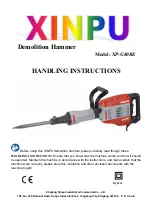
ENGLISH
en
10
long you or bystanders are being exposed.
Do not let particles enter the body.
To reduce your exposure to these chemicals: work
in a well-ventilated area, and work with approved
safety equipment, such as dust masks that are
specially designed to filter out microscopic
particles.
Observe the relevant guidelines for your material,
staff, application and place of application (e.g.
occupational health and safety regulations,
disposal).
Collect the generated particles at the source, avoid
deposits in the surrounding area.
Use suitable accessories for special work (see
chapter 11.), thus less particles enter the
environment in an uncontrolled manner.
Use a suitable extraction unit.
Reduce dust exposure with the following measures:
- Do not direct the escaping particles and the
exhaust air stream at yourself or nearby persons
or on dust deposits.
- Use an extraction unit and/or air purifiers
- Ensure good ventilation of the workplace and
keep clean using a vacuum cleaner Sweeping or
blowing stirs up dust
- Vacuum or wash the protective clothing Do not
blow, beat or brush
Transport of li-ion battery packs:
The shipping of li-ion battery pack is subject to laws
related to the carriage of hazardous goods (UN
3480 and UN 3481). Inform yourself of the currently
valid specifications when shipping li-ion battery
packs. If necessary, consult your freight forwarder.
Certified packaging is available from Metabo.
Only send the battery pack if the housing is intact
and no fluid is leaking. Remove the battery pack
from the machine for sending. Prevent the contacts
from short-circuiting (e.g. by protecting them with
adhesive tape).
See page 2.
1 Sanding attachment
2 Rotary knob for securing the sanding
attachment and adjusting the belt run
3 Cover
4 Arrow (direction of rotation of drive shaft)
5 Screw for securing the cover
6 Sanding belt
7 Tensioner arm for replacing the sanding belt
8 Sanding head
9 Locking screw for adjusting sanding head
10 Additional handle
11 Sliding on/off switch
12 Electronic signal indicator
13 Battery pack release button
14 Capacity indicator button
15 Capacity and signal indicator
16 Battery pack
17 Dust filter
6.1 Attaching the additional handle
Always work with the additional handle
attached (10)! Attach the additional handle on
the left or right of the machine and secure. Attach
the additional handle to the side facing away from
the sanding belt (6).
6.2 Turning the sanding head (8) to
operating position
Loosen the locking screw (9) using the hexagon
spanner and, if necessary and depending on the
task at hand, turn the sanding head (8). The sanding
head must be positioned in the permitted working
area as shown (see illustration A, page 2). Firmly
tighten the locking screw (9).
Each time before you start work, verify that the
locking screw (9) is sufficiently tightened to
ensure that the sanding head (8) does not move.
Otherwise, the sanding belt (6) may come in contact
with the user. Loss of control can cause personal
injury.
6.3 Dust filter
See illustration C on page 2.
Always fit the dust filter if the surroundings are
heavily polluted (17).
The machine heats up faster when the dust
filter is fitted (17). It is protected by the
electronics system from overheating (see
chapter9.).
To fit:
See fig. page 2. Attach the dust filter (17) as shown.
To remove:
Holding the dust filter at the edges, raise it slightly
(17) and then pull it downwards and remove.
6.4 Rotating battery pack
See illustration C on page 2.
The rear section of the machine can be rotated 270°
in three stages, thus allowing the machine's shape
to be adapted to the working conditions. Only
operate the machine when it is in an engaged
position.
6.5 Battery pack
Charge the battery pack before use (16).
If performance diminishes, recharge the battery
pack.
The ideal storage temperature is between 10°C and
30°C.
"Li-Power" li-ion battery packs have a capacity and
signal indicator: (15)
- Press the button (14), the LEDs indicate the
charge level.
- If one LED is flashing, the battery pack is almost
flat and must be recharged.
5. Overview
6. Initial Operation























